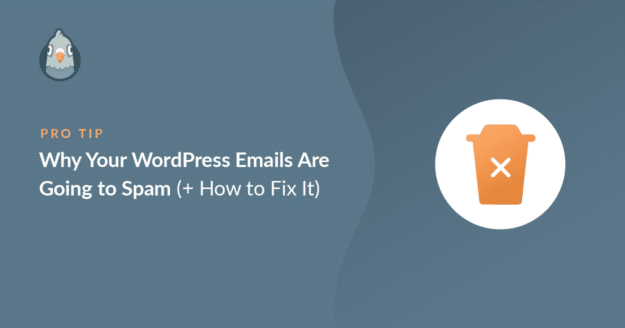AI Summary
Are your WordPress emails going to spam? I’ve run into this issue more times than I can count, especially on fresh installs or sites that rely on the default mail settings.
The thing is, WordPress isn’t built to send emails in a way that most mail servers trust by default. It uses something called the PHP mail() function, which often gets flagged as being untrustworthy.
So if your emails are getting flagged or lost, there’s a reason! And, I’ll walk you through what’s really causing it, and the exact steps you can take to fix it fast.
Why Are My Emails Going to Spam?
Your WordPress emails are sent from your web server to the recipient’s email address. And since most web hosting servers can send emails, there’s a good chance that your email will be generated and sent without any trouble.
So, why do emails go to spam? The problem occurs after the server has generated and sent the email. When that email gets passed from one server to another on its way to the recipient, it gets flagged as a spam email and either discarded or filed in the Junk Mail.
This happens because WordPress doesn’t add any authentication to your outgoing messages. As a result, there’s no way for the email server that receives the message to verify that it really came from you. Providers like Gmail are now blocking emails that don’t have authentication.
You can use WP Mail SMTP to fix this problem. WP Mail SMTP re-routes your emails through a real email server to apply the right authentication.
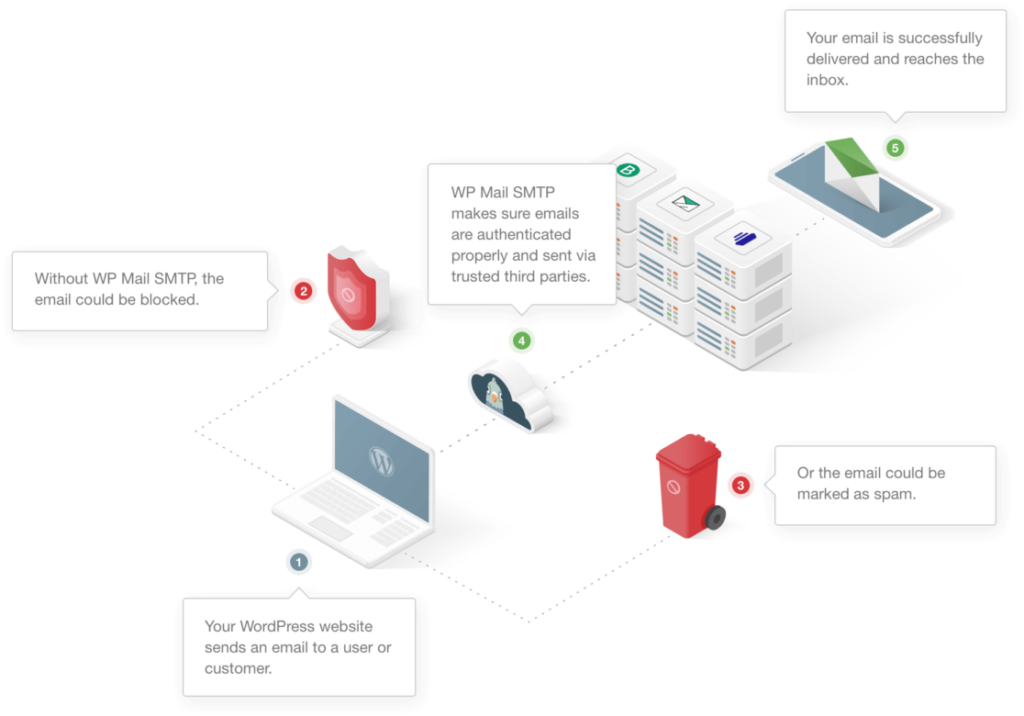
How to Stop WordPress Emails Going to Spam
Wondering how to avoid WordPress emails going to spam? Just follow these steps:
- 1. Troubleshooting WordPress Emails Going to Spam
- 2. Installing the WP Mail SMTP Plugin
- 3. Choosing an Email Provider for WordPress
- 4. Setting the From Name and From Email
- 5. Setting Up Smart Routing (Optional)
- 6. Configuring DNS for Proper Authentication
1. Troubleshooting WordPress Emails Going to Spam
If you’re wondering why your website emails are going to spam (or disappearing), first run through these troubleshooting steps below.
Is Your Server on a Spam Blacklist?
If your server is blacklisted, that means it’s been flagged for spamming in the past. That means your emails won’t be trusted.
This is a common problem with shared hosting. If just 1 customer is blacklisted for spamming, all of the other customers on the same server will have issues sending emails.
This can also happen if your site is infected with malware, or if a hacker is using your server as an email relay.
How To Tell if Your Emails are Going to Spam
If you want to check if your emails are going to spam, you can check if you’re on a spam blacklist.
To do that, test your server IP address using the MXToolbox blacklists checker. Just hit Blacklist Check to scan 100+ blacklists at once.

If you find that you’re on a blacklist, reach out to your host and ask them to move you to a different server.
Are Some WordPress Emails Going to Spam, But Not Others?
Sometimes you’ll notice that emails go to spam for one recipient, but others can receive them without any issues. This is super common for recipients using AOL, Yahoo, or Gmail.
These providers tend to apply much stricter spam checks. For example, Yahoo can reject any email from a domain without a DMARC record. Gmail and Yahoo both introduced strict new sender requirements in early 2024.
While these requirements are aimed at bulk senders (those who send more than 5,000 emails a day), Google has also stated that all email senders must comply with some of the new requirements, such as authenticating the sending domain and keeping spam complaint rates low.
You can find out more about these updated requirements in our guide to fixing Gmail blocking emails. Gmail may also display a “Be careful with this message” warning if it detects something unusual in your email headers.

You can usually fix this by checking your DNS records, which we’ll cover later in the tutorial.
However, if just 1 person is not receiving your emails, you’ll also want to check that they haven’t marked your previous emails as spam. If this has happened, you’ll want to contact your email service provider and ask if you can remove that person from the suppressions list.
It’s also a good idea to avoid using “no-reply” email addresses as the From email because some email providers are more likely to send these emails to spam.
Are You Sending Images or Attachments?
Every email you send has a spam score, and including images or attachments will increase that score.
So although you can send emails with attachments in WordPress, the size of the attachments matters. Multiple attachments may even make your email content look more spammy.
Not sure if this applies to you? If you already have WP Mail SMTP Pro, it’ll show the number of attachments in the email log.
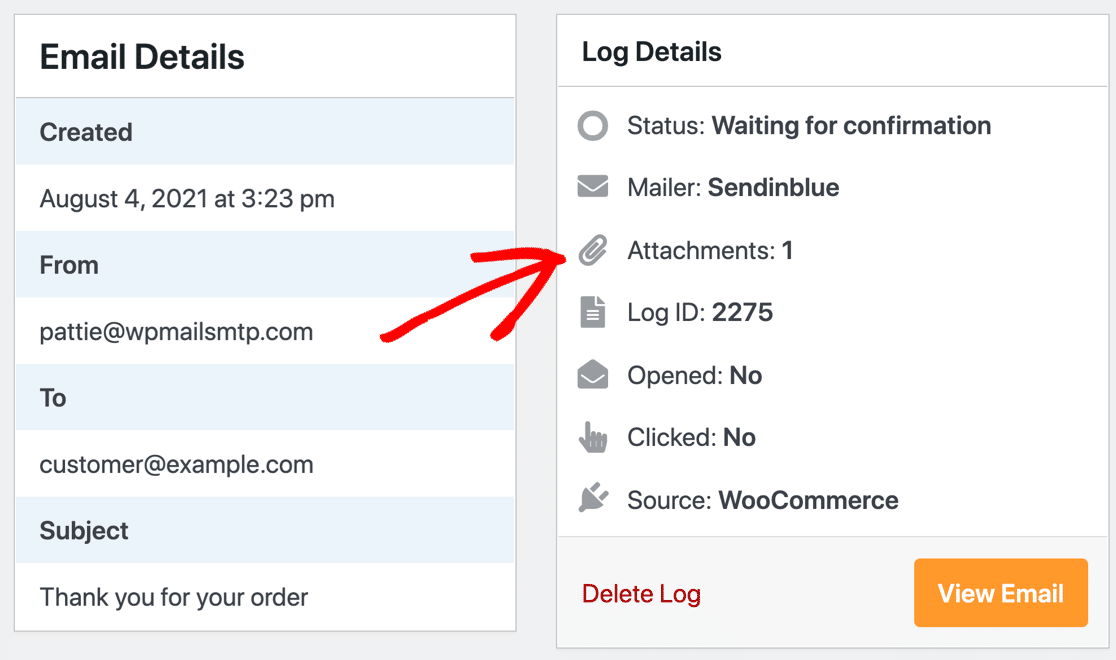
Additionally, large images or attachments can cause emails to fail because of sending limits applied by the sender or recipient’s mailbox. WP Mail SMTP lets you save sent attachments to avoid losing important files.
Are You Using an Unusual TLD?
Spam scores are calculated using a range of factors, and the top-level domain (TLD) can be one of them. The top-level domain is the part of the domain after the final period.
According to Spamhaus, the TLDs most abused by spammers include .work, .shop, and .biz. (These are all gTLDs, which means they don’t belong to a particular geographical location.)
Using a non-traditional gTLD won’t definitely mark you out as a spammer. But if your emails are already triggering spam filters and increasing the spam score on your emails, having one of these gTLDs might tip you over into a higher spam score.
This is one of the reasons WPBeginner recommends that you use a traditional TLD like .com when choosing the best domain name.
Is Your Email List Out-of-Date?
Another reason that can increase your spam score and affect your domain reputation is an outdated email list.
The email addresses in your email list may no longer be in use by your subscribers. Or some people on your list may simply not want to receive emails from you anymore.
Whatever the case, if your emails are continuously going unopened by people on your list, then you’re at risk of being flagged as spam.
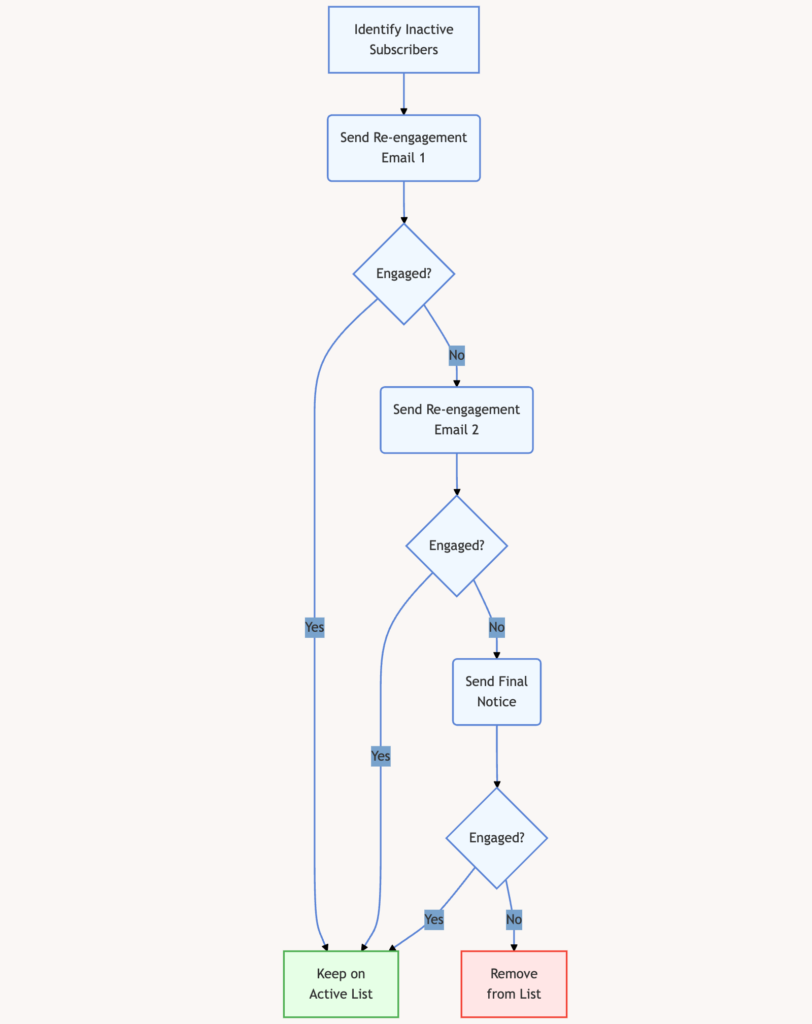
It’s a good idea to send a check-in email to your subscribers every now and then. This way, you can confirm if they’re still interested in your newsletter and that their email addresses are active.
Then, you can remove inactive subscribers and clean your email list to maintain a high domain reputation and avoid being marked as spam.
Also, make sure that your subscribers have an easy way to unsubscribe from your newsletter at any point in time. For instance, you can simply add an unsubscribe link at the bottom of your email.
WordPress Emails Still Going to Spam?
If none of these problems apply to you, it’s likely that the problem is simply missing authentication. We can fix that with WP Mail SMTP. This solution works for all plugins installed on your site that send emails.
So, whether you have WooCommerce emails going to spam or any other WordPress plugin, WP Mail SMTP should help fix your deliverability issues once and for all.
2. Installing the WP Mail SMTP Plugin
WP Mail SMTP is the best SMTP plugin for WordPress. It supports free and premium email providers that’ll solve your WordPress email issues.
To download the plugin, go to the WP Mail SMTP website and log in to your account. Switch to the Downloads tab to grab the latest version of the plugin file.
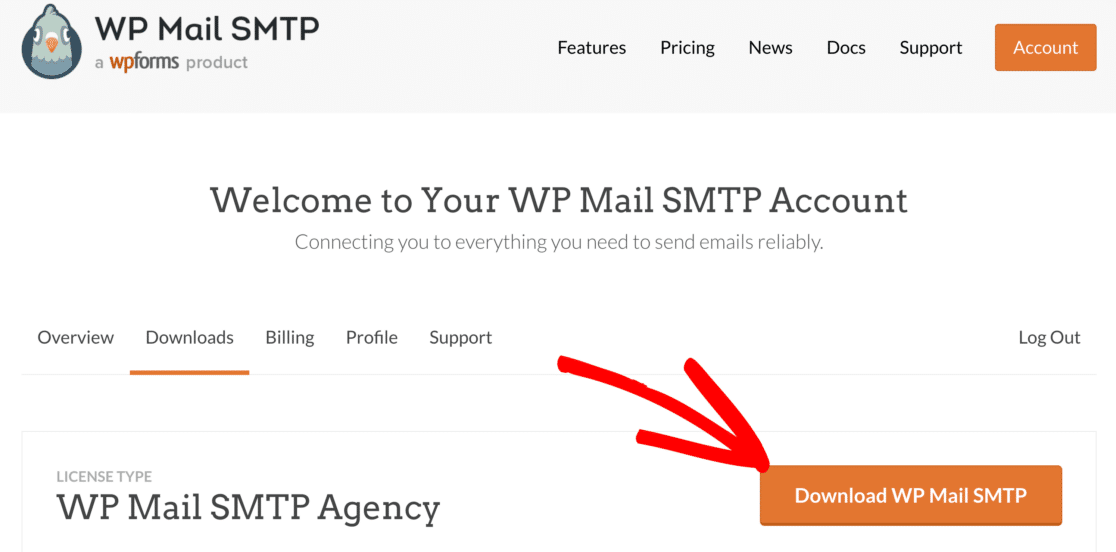
Go to your website and log in to the WordPress dashboard. Now, navigate to the plugins page and upload the zip file that you just downloaded to install it.

Once the plugin is installed, be sure to activate it. As soon as you do this, the Setup Wizard of the plugin will launch in your browser.
It’s important to complete the entire Setup Wizard to fix the issue. Remember: if you install the plugin and you don’t set it up, it won’t have any effect.
Need a hand?
Our Elite license includes White Glove Setup for WP Mail SMTP.
3. Choosing an Email Provider for WordPress
In this step, we’re going to choose the email provider that’ll deliver your WordPress emails.
On the first screen of the wizard, click the Let’s Get Started button to begin.
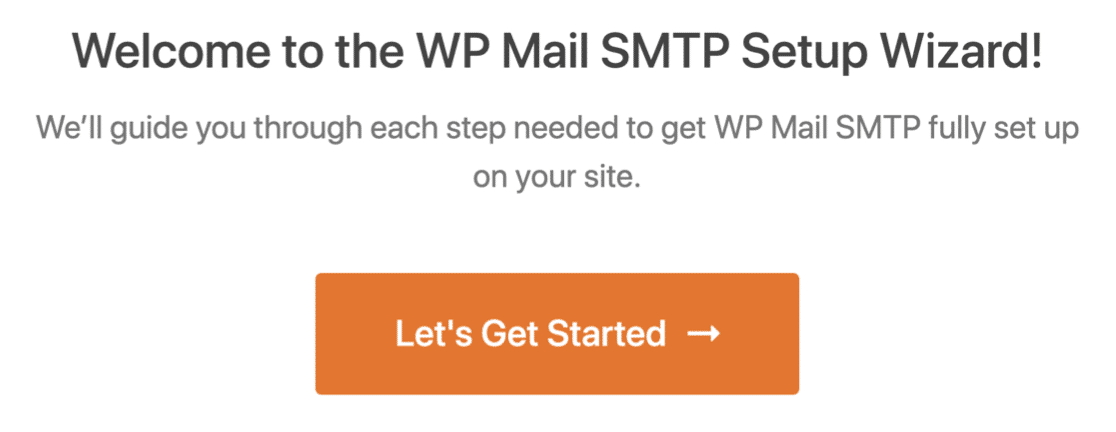
WP Mail SMTP will display a list of mailer services that it supports.
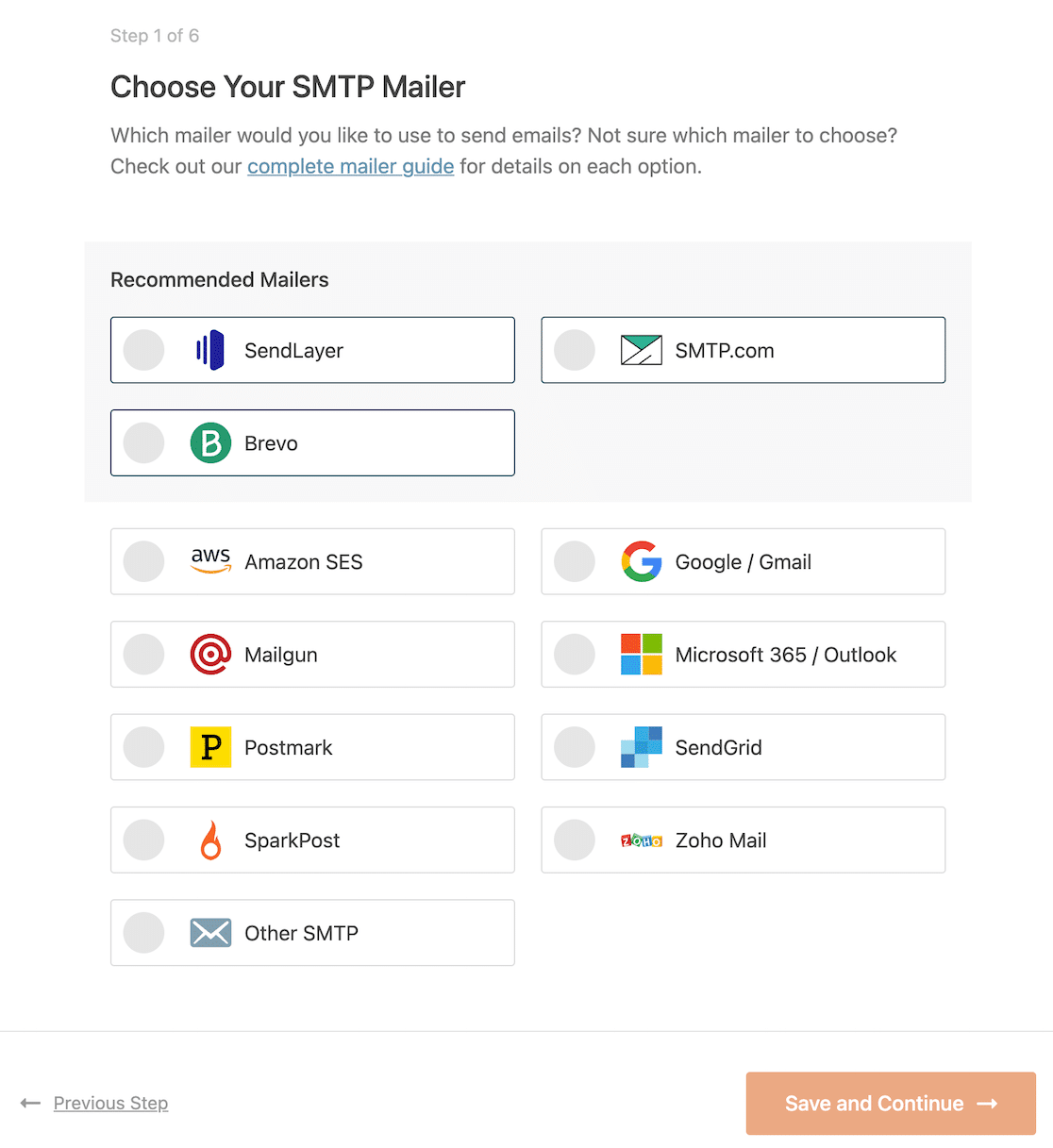
Any of these email providers will help prevent your WordPress emails from going to spam. But they all have different sending limits and allowances for attachments.
In addition, some are easier to set up than others.
If you want a reliable, professional, and affordable service, we recommend SendLayer, SMTP.com, or Brevo (formerly Sendinblue). These are transactional email providers, which means they’re designed to handle large numbers of automated notification emails.
They’re also easy to set up compared to Gmail or Outlook.
Once you’ve chosen your email provider, click on the link below to open up the documentation for it. We’ve produced a complete guide for every mailer so you can easily get your WordPress site connected:
| Mailers available in all versions | Mailers in WP Mail SMTP Pro |
|---|---|
| SendLayer | Amazon SES |
| SMTP.com | Microsoft 365 / Outlook.com |
| Brevo | Zoho Mail |
| Google Workspace / Gmail | |
| Mailgun | |
| Postmark | |
| SendGrid | |
| SparkPost | |
| Other SMTP |
Once you’re done, you can continue with the Wizard.
If you have a Pro license, we strongly recommend that you turn on Detailed Email Logs and the Weekly Email Summary in the final step.
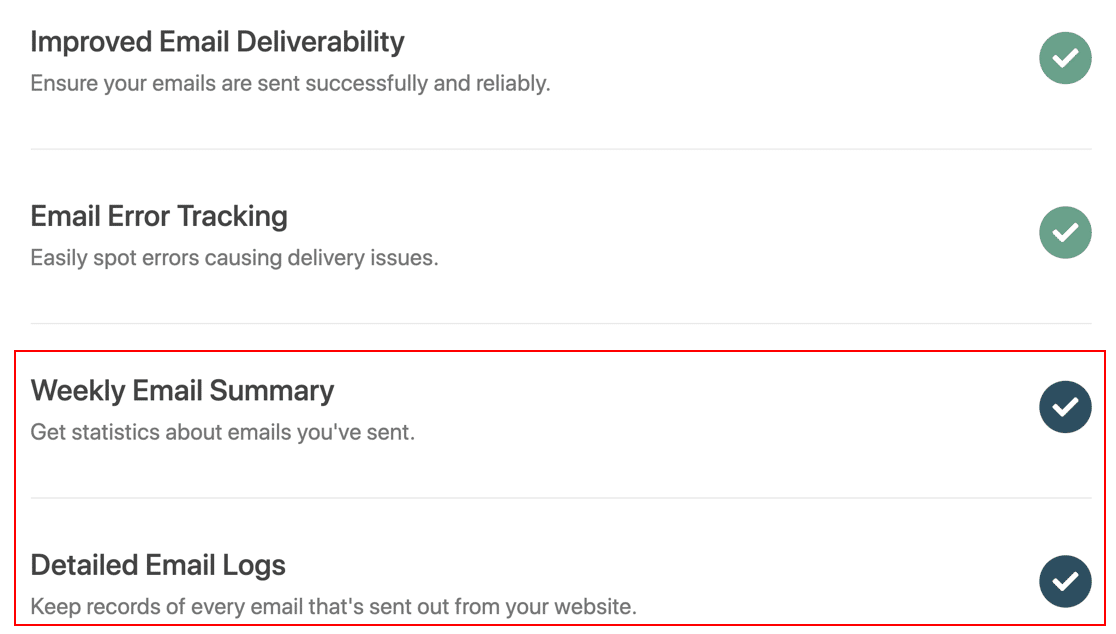
When you enable these features, you unlock a ton of extra functionality in WP Mail SMTP:
- Full email logging: Save a copy of the body of each email along with the headers
- Open and click tracking: See open and click analytics for your WordPress emails
- Save email attachments: Store every attachment sent from WordPress
- Export email logs: Export details of sent emails and any attachments
- Export in EML format: Save a complete copy of a sent email and its attachments
- Email resend: Resend failed emails individually or in bulk – ideal if you want to resend the new user registration email in WordPress
- Weekly updates: Get an email report every Monday showing your email deliverability statistics, open rates, and click-through rates.
Read our article on how to log WordPress emails to get more details.
And that’s it! WP Mail SMTP will send an automatic test email so you can check that everything’s working.
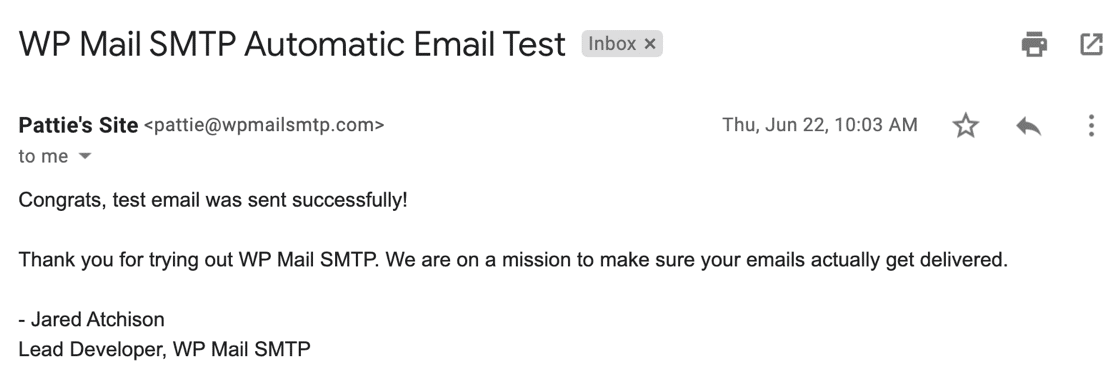
You’ll notice that WP Mail SMTP asked you if you wanted to force the Form Name. Let’s take a look at what this means.
4. Setting the From Name and From Email
The From Name and From Email are important settings when sending emails from your WordPress website.
The From Name is the sender’s name, and the From Email is the email address that the alert or notification is sent from.
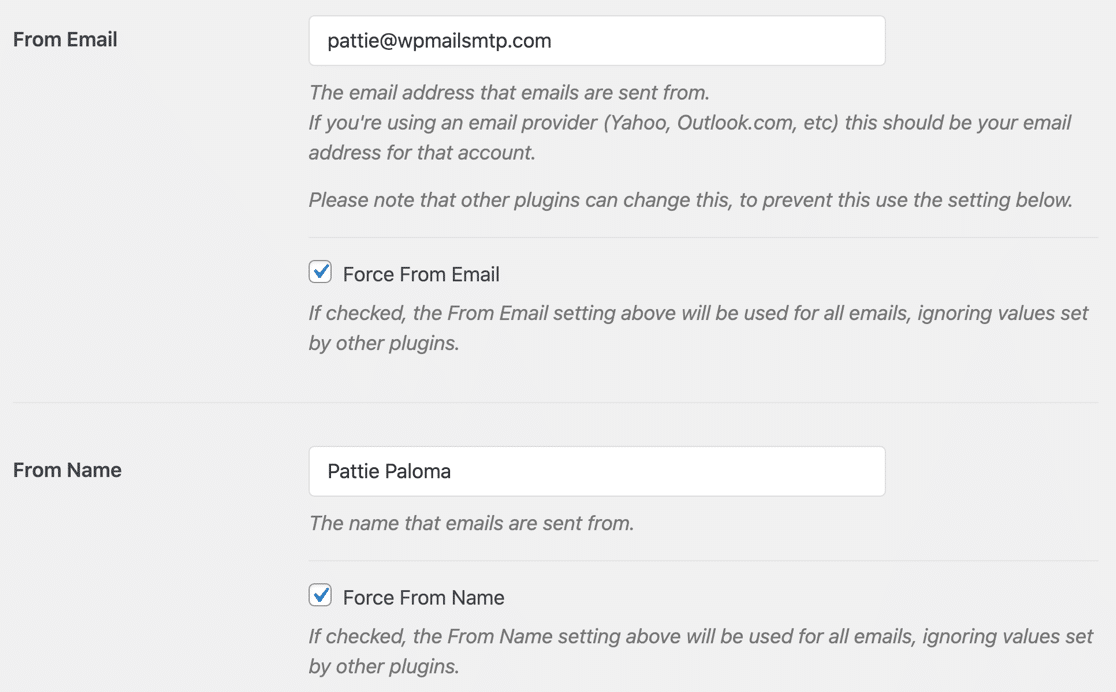
The From Email is the important setting here. It’s super important that the From Email is set up correctly to stop WordPress emails going to spam.
You can check your From Email in WP Mail SMTP » Settings.
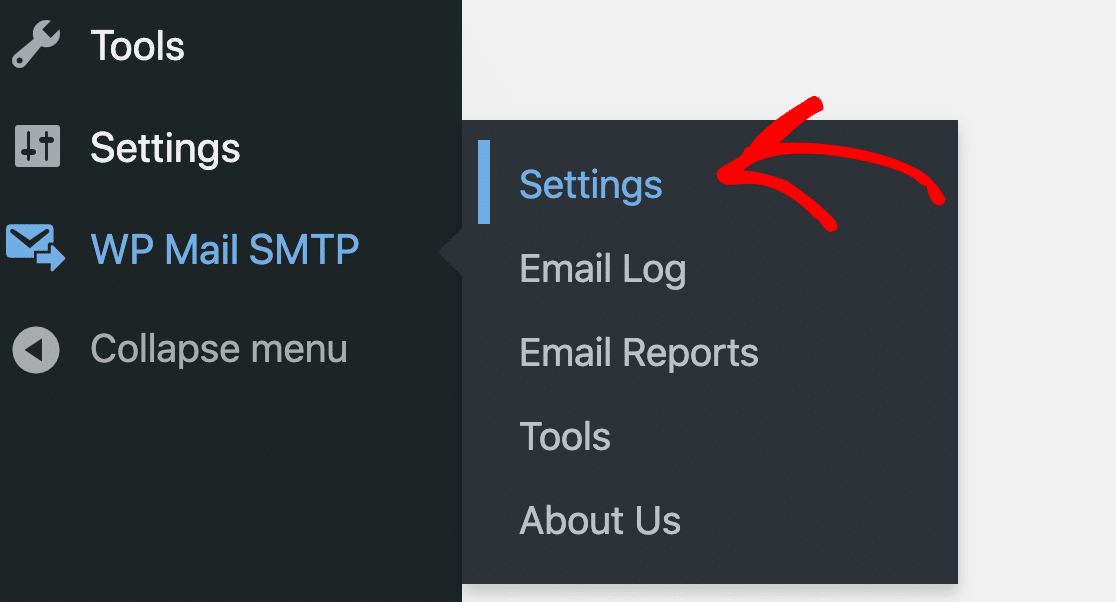
Some mailers will allow you to type in any From Email you want. In this case, you should use an email at the domain you authenticated with your email provider.
For example, if you authenticated example.com when you set up SendLayer, your email domain should also end with example.com.
Forcing that across your entire WordPress site will give you the peace of mind that all your emails are authenticated.

If the From Email is grayed out, you won’t be able to change it.

Some email providers (including Zoho Mail) don’t allow you to use a different From Email from the one you authenticated when you set up the plugin. So we gray out this setting to make sure your emails don’t fail.
If you’re using Gmail or Google Workspace, you can use any Gmail alias to send emails from WordPress. In this case, you’ll see a dropdown so you can choose your primary From Email when you run the Setup Wizard.
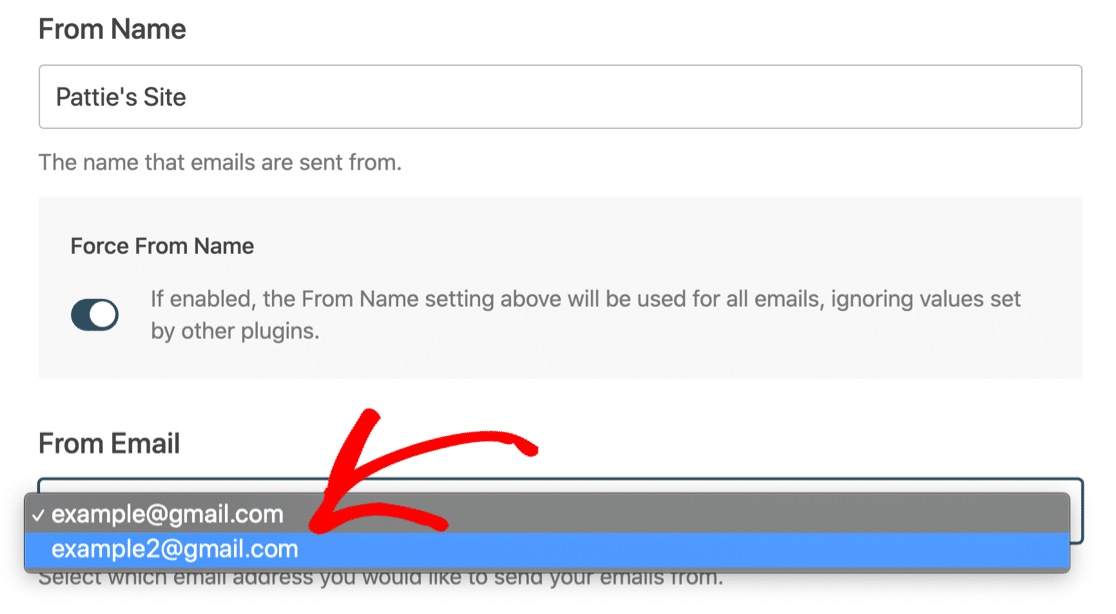
You can use any of these aliases to send emails from WordPress. Keep in mind that the primary Google alias will be used as a From Email if you try to use an email that doesn’t exist in your Gmail account.
5. Setting Up Smart Routing (Optional)
WP Mail SMTP Pro lets you set up Smart Routing. This feature enables you to use different mailers for different types of emails.
This can help with email deliverability because certain different mailers work best for different types of emails. For example, it’s often recommended that you use a transactional mailer for eCommerce order notifications.
Choosing the right mailer for the type of emails you’re trying to send can help you prevent your emails from going to spam.
To set up Smart Routing, you first have to add an additional connection. Go to WP Mail SMTP » Settings and click on Additional Connections.
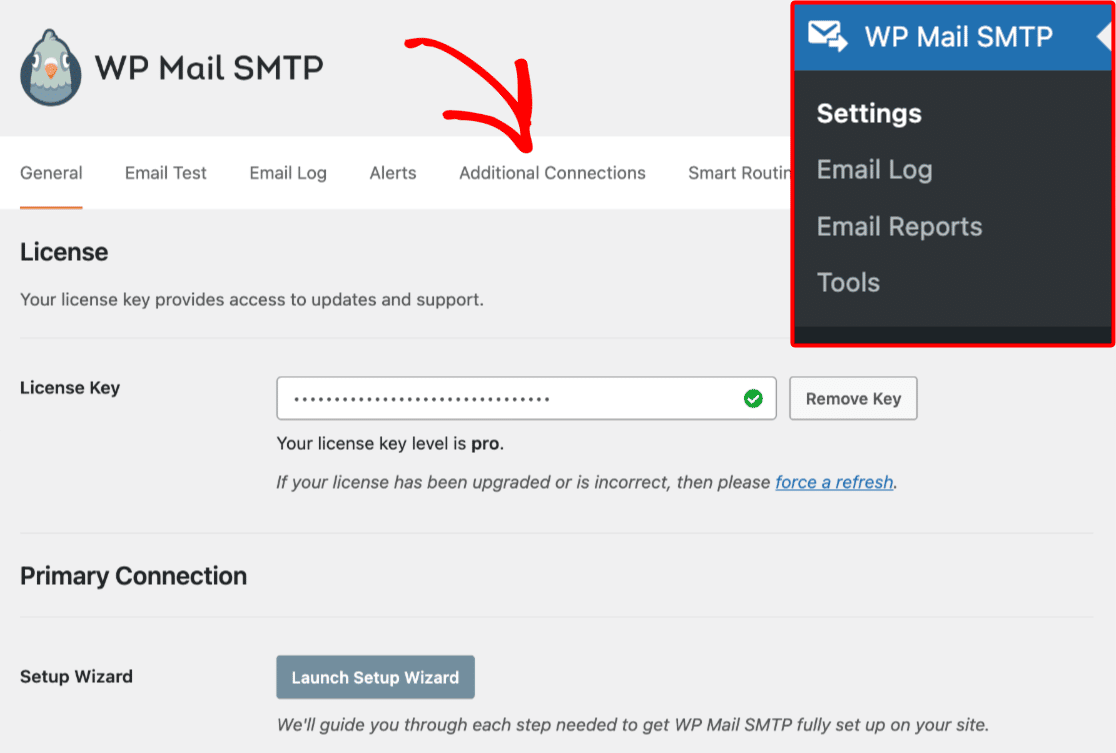
Then add a new connection and fill out the settings. These are the same as the options for your Primary Connection that you set up earlier in this tutorial.
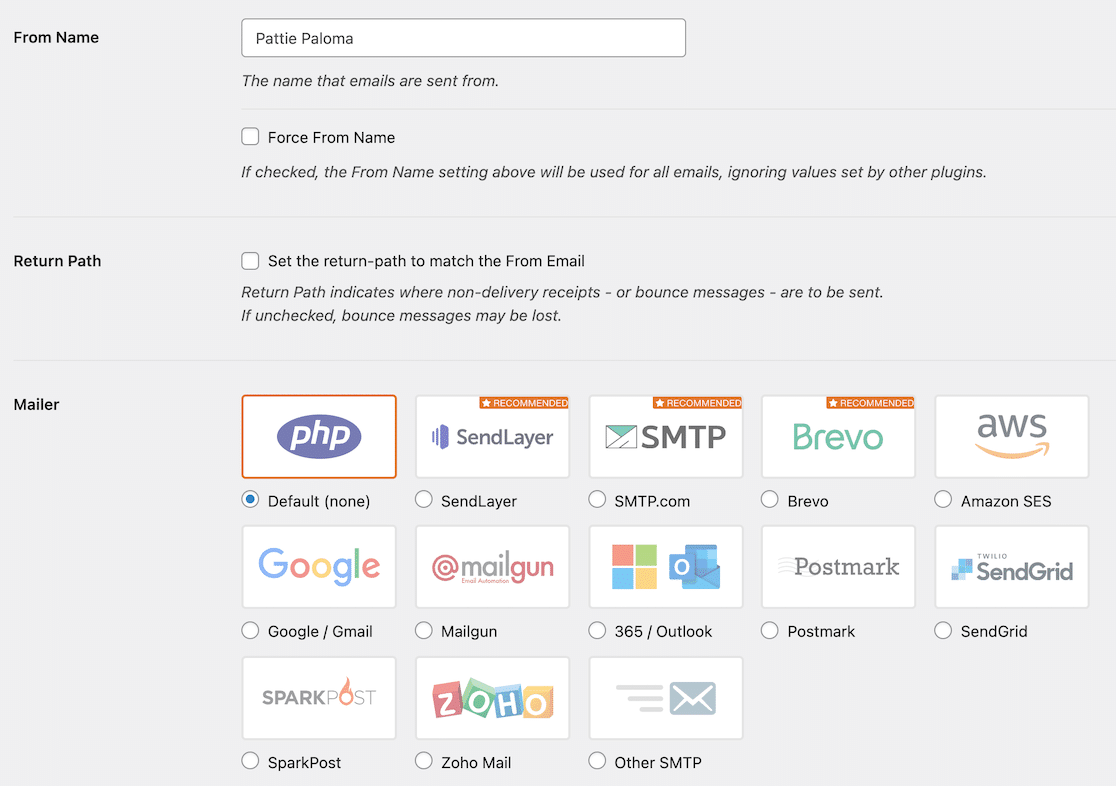
Once you have at least 1 additional connection, you can enable Smart Routing. Go to the Smart Routing settings page and use the dropdowns to create a conditional rule.
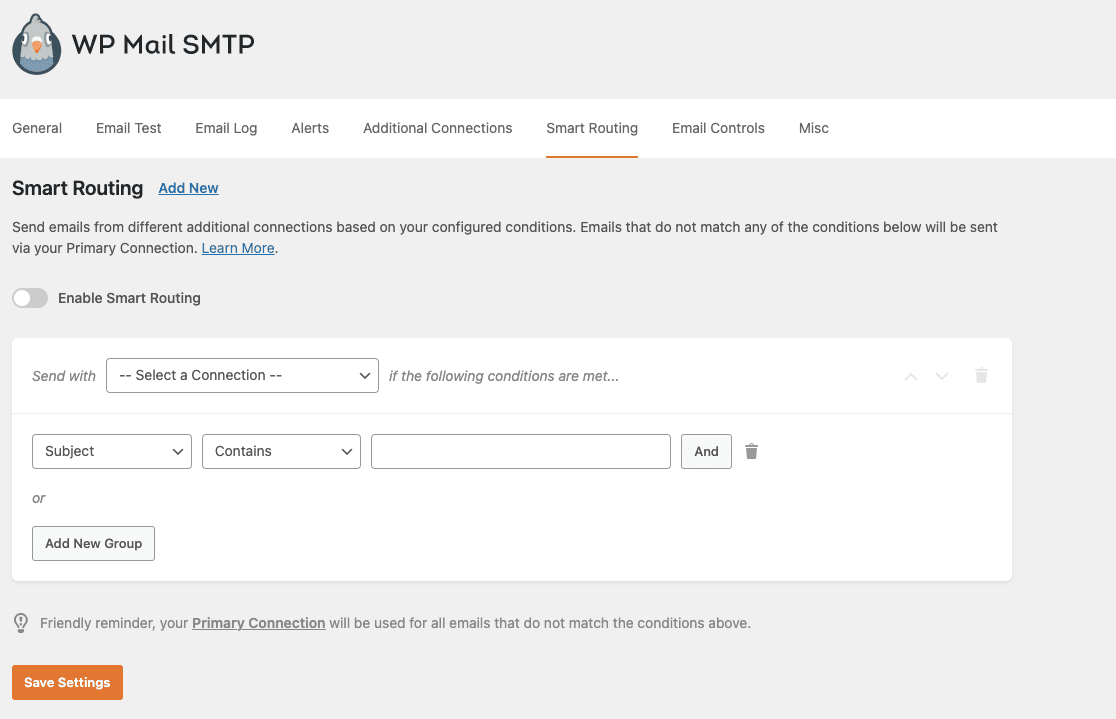
This will tell WP Mail SMTP when to send emails using your additional connection. Any emails that don’t meet the requirements you set up here will be sent using your Primary Connection.
For more details, see our guide on Smart Routing.
6. Configuring DNS for Proper Authentication
Sometimes WordPress emails go to spam even after you’ve set up WP Mail SMTP. This is almost always caused by incorrect DNS settings at your domain.
Your email provider may need you to set up SPF, DMARC, and DKIM records to authenticate your WordPress emails. If you skip this step, your WordPress emails will likely still land in the Junk Mail folder.
Luckily, WP Mail SMTP has a built-in DNS checker that automatically scans your DNS for problems. Just send a test email to find out what authentication is missing.
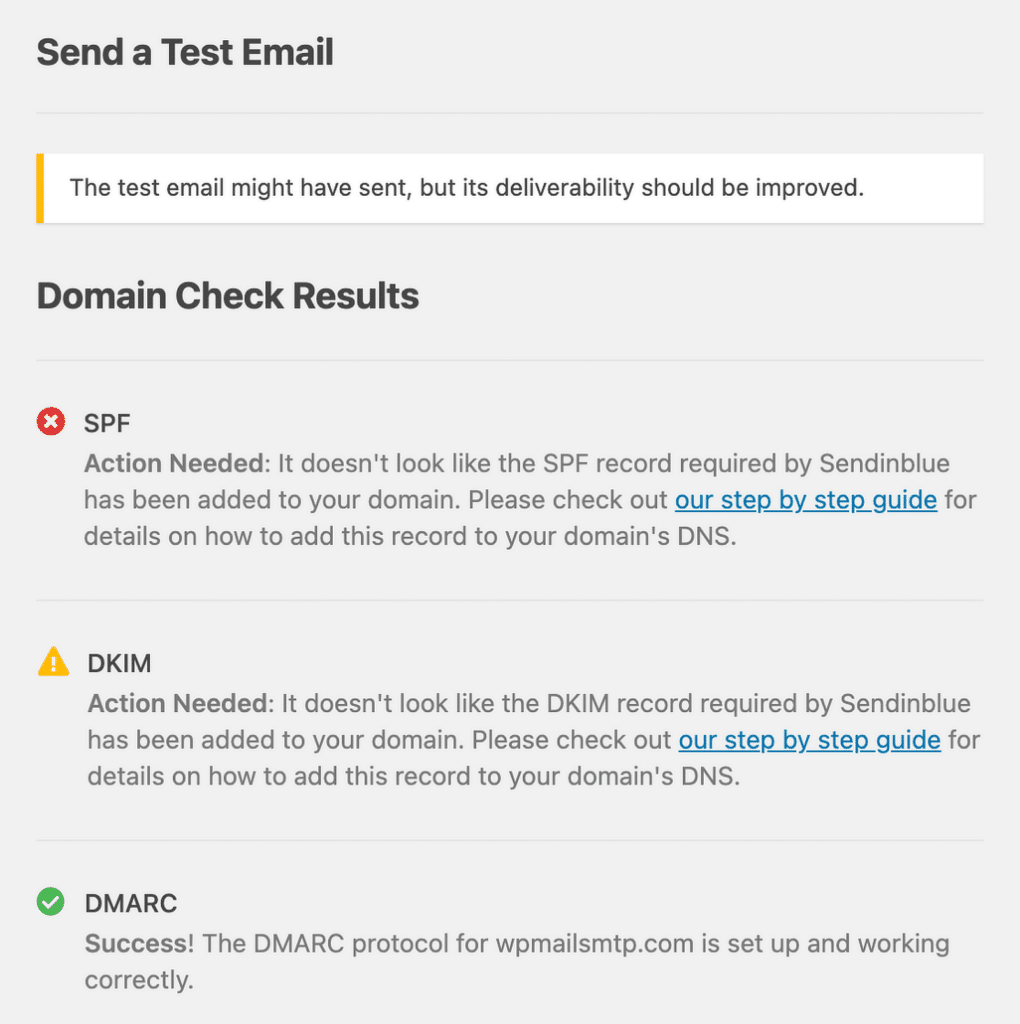
Pay attention to any SPF, SKIM, or DMARC warnings you receive in WP Mail SMTP. Getting these settings right is a crucial step to stop WordPress emails going to spam.
Not sure where to start? We’ve included complete DNS setup steps in our mailer documentation to get you on the right track. Start with this guide on how to create a DMARC record.
FAQs on Why Your WordPress Emails Are Going to Spam (+ How to Fix It)
WordPress emails going to spam is a popular topic of interest among our readers. Here are answers to some common queries about it:
Why are my WordPress emails going to spam?
WordPress sends email without using proper authentication. This makes the message look suspicious to email services, even if it’s safe. The best fix is to install an SMTP plugin and use a verified mailer.
How do I stop WooCommerce emails going to spam?
Use an SMTP plugin to send your emails through a verified mail service. Make sure SPF and DKIM records are added to your domain.
What is mail1.wpengine.com in my email header?
That’s WP Engine’s mail server. If you want to use your own domain, set up an SMTP plugin and connect a mail service that lets you send as your own address.
Do I need SPF and DKIM for WordPress email?
Yes. These records show that your domain is allowed to send email. Without them, your messages are more likely to go to spam.
Can SendGrid emails go to spam?
Yes. Even with a good mailer like SendGrid, you still need working SPF and DKIM records and a good sender reputation to keep your emails out of spam.
Next, Stop Spam From Your Contact Form
Now that you’ve fixed your WordPress emails going to spam, you might have another issue: getting spam from your contact form.
AI spam filters, particularly those in WPForms, offer a smart solution by automatically distinguishing between genuine interactions and spam.
Also, check out the best contact form plugins to see how to stop contact form spam using CAPTCHAs and secret form tokens.
Ready to fix your emails? Get started today with the best WordPress SMTP plugin. If you don’t have the time to fix your emails, you can get full White Glove Setup assistance as an extra purchase, and there’s a 14-day money-back guarantee for all paid plans.
If this article helped you out, please follow us on Facebook and Twitter for more WordPress tips and tutorials.

